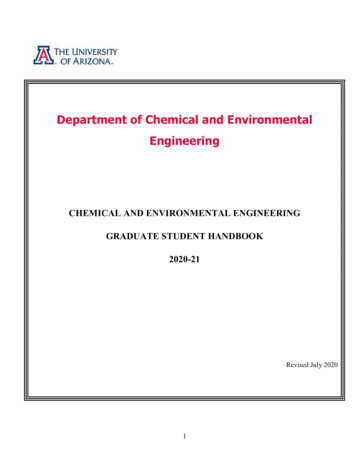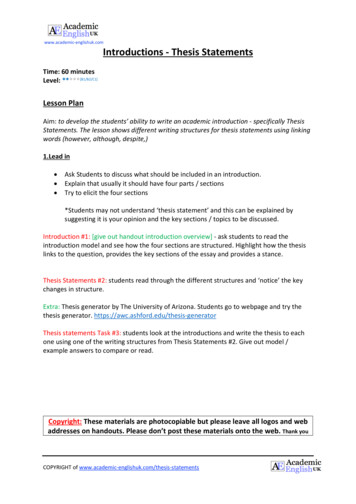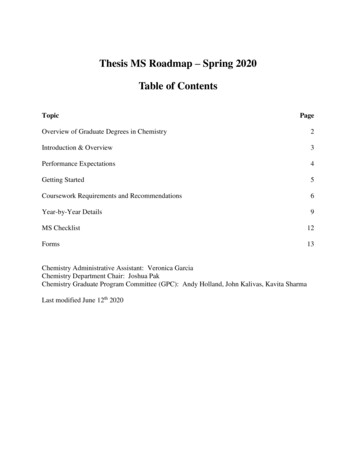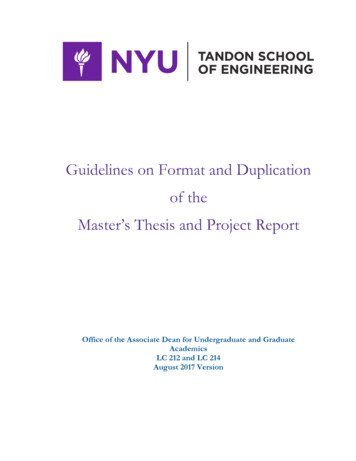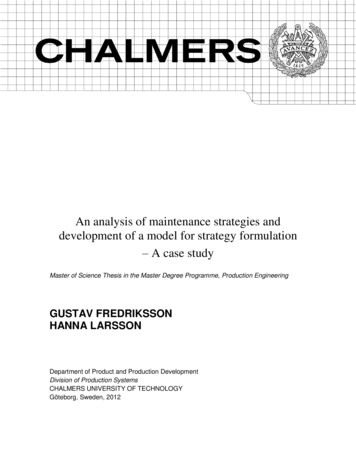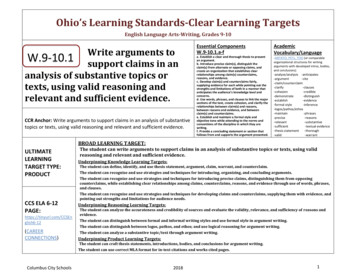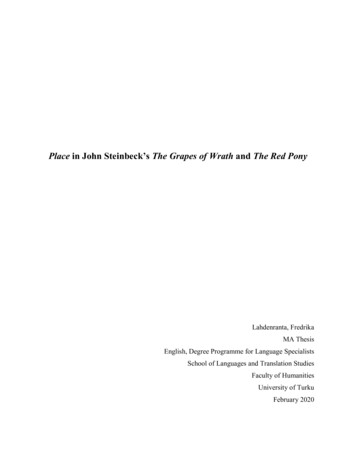
Transcription
Master ThesisIndustry 4.0 Adoption in theManufacturing ProcessMultiple case study of electronic manufacturers and machinemanufacturersAuthor: John Gerhard Olsson,Xu YuanjingSupervisor: Åsa GustavssonExaminer: Helena ForslundAcademic term: VT2018Subject: Business Process andSupply Chain ManagementLevel: Second cycleCourse code: 5FE04E
AbstractTitle: Industry 4.0 Adoption in the Manufacturing Process. Multiple case study ofelectronic manufacturers and machine manufacturersAuthors: John Gerhard Olsson, Xu YuanjingBackground: Changing market conditions and increasing competition drive companiesto increase their collaboration along the supply chain. Technological innovations enablebusinesses to increase their integration tremendously. The fourth industrial revolution(Industry 4.0) enables the integration of information technology with industrialtechnology. The adoption of Industry 4.0 includes many complex technologies thatcome with challenges for many organizations. Previous research suggests thatconventional manufacturing might have to be adjusted to Industry 4.0.Purpose: This thesis identifies and analyzes potential challenges of Industry 4.0adoption for electronics manufacturers and machine manufacturers and analyzes howprocesses in manufacturing need to be adjusted to successfully implement Industry 4.0.The purpose of this thesis is to contribute to successful Industry 4.0 adoption in themanufacturing process and therefore to contribute to technological advancement.Method This thesis conducts a multiple case study and gathers qualitative data byconducting semi-structured interviews.Findings & conclusion: Challenges identified for most companies are standardization,management support, skills and costs. Most companies face data and compatibilitychallenges. Some companies face the challenge of complexity, information security,scalability and network externalities. Companies with higher levels of maturity are lesslikely to face environmental challenges.Lean Management was identified as a prerequisite for Industry 4.0 adoption. Theadoption of Industry 4.0 is likely to lead to a paperless factory. Furthermore, changesconcerning the infrastructure are a main finding. Moreover, it was found that Industry4.0 does not require major changes from conventional manufacturing processes.KeywordsIndustry 4.0; Manufacturing; Innovation Adoption Process; Adoption Challenges;Electronic Manufacturing; Machine Manufacturing; Multiple Case Study.ii
AcknowledgementThis master thesis was written during the spring semester 2018 as final degree projectwithin the master program “Business Process and Supply Chain Management” atLinnaeus University in Växjö, Sweden. The research and writing process was veryexciting but also challenging for both researchers and would not have been possible,with the same outcome, without those who supported us in different ways.We would therefore like to thank our examiner, Helena Forslund, for her extensivefeedback and her availability for questions of all kind, not only during the degreeproject but also as program director during our entire master studies. Furthermore, wewould like to thank our tutor, Åsa Gustavsson, for her contributions to this thesis.Moreover, we would like to thank Gregory Johnson who has supported us with practicaladvice beyond the scope of academia.Access to empirical data was crucial for this master thesis, we would therefore like toexpress our deepest gratitude to all participating companies who have supported ourresearch with interviews and who have shown great interest in our research. We havelearned a lot from all companies and obtained valuable insights from all interviewees.Feedback is an important element of every academic writing process, we wouldtherefore like to thank our fellow students who have given us very constructive andextensive feedback and thereby supported the progress of our work.Last but not least we would like to thank Fredrik Karlsson, Jan Alpenberg, ClaudiaKopf, Lola Girot, Linnéa Johansson, Pascalina Hiller, Kai Yang and Zhou Shang Jingfor their different contributions to our work.John Gerhard Olsson and Xu Yuanjingiii
Contents1 Introduction 1Background 1Problem Discussion 21.2.1 RQ1: Identification of Adoption Challenges 21.2.2 RQ2: Adjustment of Manufacturing Processes 4Purpose and Research Questions 4Delimitations 5Structure and Approach 52 Methodology 7Research Philosophy 7Research Approach 8Research Design 9Research Purpose 10Research Method 11Population and Sampling 13Data Collection Methods 15Data Analysis Methods 16Research Quality 18Ethics 20Summary of Methodological Choices 21Research Working Process 223 Theoretical Framework 23Industry 4.0 233.1.1 Key technologies of Industry 4.0 243.1.1.1 Cyber-Physical Systems (CPS) 243.1.1.2 Internet of Things (IoT) and Internet of Services (IoS) 253.1.1.3 Big Data (BD) 263.1.1.4 Cloud Manufacturing (CM) 263.1.1.5 Augmented Reality (AR) 273.1.1.6 Smart Factory 283.1.1.7 Summary of Key Features of Industry 4.0 293.1.2 Challenges of adopting Industry 4.0 313.1.2.1 Cyber-Physical Systems (CPS) 313.1.2.2 Internet of Things (IoT) and Internet of Services (IoS) 313.1.2.3 Big Data (BD) 323.1.2.4 Cloud Manufacturing (CM) 333.1.2.5 Augmented Reality (AR) 343.1.2.6 Smart Factory 353.1.2.7 General Challenges of Industry 4.0 adoption 36Adoption of Industry 4.0 363.2.1 Diffusion of Innovations 373.2.2 The Innovation Process 383.2.3 The Technology-Organization-Environment Framework 423.2.4 Suggested Process for the Adoption of Technological Innovation 433.2.5 Suggested Maturity Model for the Adoption of Industry 4.0 45iv
4 Frame of Reference 47Research Model 47Operationalization 485 Empirical Description 51Case A 51Case B 52Case C 53Case D 54Case E 546 Analysis 56Maturity Model, Innovativeness and Adoption Process 566.1.1 Case A 566.1.2 Case B 586.1.3 Case C 606.1.4 Case D 626.1.5 Case E 64Challenges of Industry 4.0 Adoption 656.2.1 Case A 656.2.1.1 Technological Context 656.2.1.2 Organizational Context 666.2.1.3 Environmental Context 676.2.2 Case B 686.2.2.1 Technological Context 686.2.2.2 Organizational Context 686.2.2.3 Environmental Context 696.2.3 Case C 696.2.3.1 Technological Context 696.2.3.2 Organizational Context 706.2.3.3 Environmental Context 706.2.4 Case D 716.2.4.1 Technological Context 716.2.4.2 Organizational Context 716.2.4.3 Environmental Context 726.2.5 Case E 726.2.5.1 Technological Context 726.2.5.2 Organizational Context 736.2.5.3 Environmental Context 736.2.6 Cross-Case Synthesis 74Adjustment of Conventional Manufacturing Processes 766.3.1 Case A 766.3.2 Case B 776.3.3 Case C 796.3.4 Case D 806.3.5 Case E 816.3.6 Cross-Case Synthesis 827 Discussion 86Maturity of Case Companies 86v
Challenges of Industry 4.0 Adoption in the Manufacturing Process 86Adjustment of conventional Manufacturing Processes 88Societal and Ethical Aspects 898 Conclusion 91Answer to the first research question 91Answer to the second research question 91Comparison between Findings and expected Outcome 92Theoretical Contribution and Managerial Implications 92Limitations and Generalizability 94Suggestions for further Research 94References XAppendix A XVIManufacturing Processes – SCOR XVIAppendix B XVIIICase A XVIIICase B XXICase C XXVIICase D XXXIIICase E XXXVIIvi
List of FiguresFigure 1 Research structure (own illustration). 6Figure 2 Basic types of Designs for Case Study (adopted from Yin, 2014, p. 50) 12Figure 3 Population, target population, sample and individual cases (adopted fromSaunders, Lewis and Thornhill, 2016, p. 275) 13Figure 4 Summary of Methodological Choices (adopted from Saunders, Lewis andThornhill, 2016, p. 124) 21Figure 5 Relationship between the research questions and the theoreticalframework (Own illustration) 23Figure 6 Concepts of Industry 4.0 (DFKI, 2011, cited in Zhou, Liu and Zhou, 2015,p. 2148) 24Figure 7 Cloud Manufacturing concept (Adamson, et al., 2017, p.348) 27Figure 8 AR glasses (Wikimedia, 2017) 28Figure 9 A brief framework of the Smart Factory of Industry 4.0 (Wang, et al.,2015, p. 3) 29Figure 10 Summary of Key Features of Industry 4.0 (Own illustration) 30Figure 11 Conceptual classification of BD challenges (Akerkar, 2014; Zicari,2014; cited in Sivarajah, Kamal and Weerakkody, 2017, p. 265) 33Figure 12 Adopter Categorization on the Basis of Innovativeness (Rogers, 2003, p.281) 38Figure 13 The innovation process in an organization (adopted from Rogers, 2003,p. 421) 39Figure 14 Conceptual model for the process of IT innovation adoption (Hameed,Counsell and Swift, 2012, p. 367) 41Figure 15 The technology–organization–environment framework (Adopted fromBaker, 2012, p. 236) 42Figure 16 Model for adoption of Technological Innovation (Own illustration) 44Figure 17 Research Model (Own illustration) 47Figure 18 Analysis outline (Own illustration) 56Figure 19 Summary of challenges from the cross-case analysis (Own illustration)76Figure 20 SCOR is organized around six major management processes (APICS,2017, p. V) XVIIvii
List of TablesTable 1 Self-Sampling Results (Own illustration) . 15Table 2 Summary of methodological choices (Own illustration) . 22Table 3 Maturity model for the adoption of industry 4.0 in the manufacturingprocess (Own illustration) . 46Table 4 Operationalization of Industry 4.0 and associated key technologies (Ownillustration) . 48Table 5 Operationalization of innovations and their contexts (Own illustration) . 49Table 6 Operationalization of key challenges to Industry 4.0 adoption (Ownillustration) . 50Table 7 Overview interviewees case A (Own illustration) . 51Table 8 Overview interviewees case B (Own illustration) . 52Table 9 Overview interviewees case C (Own illustration) . 53Table 10 Overview interviewees case D (Own illustration) . 54Table 11 Overview interviewees case E (Own illustration) . 55Table 12 Maturity, Innovativeness and Adoption in Case A - Summary (Ownillustration) . 58Table 13 Maturity, Innovativeness and adoption in Case B – Summary (Ownillustration) . 60Table 14 Maturity, Innovativeness and adoption in Case C – Summary (Ownillustration) . 62Table 15 Maturity, Innovativeness and adoption in Case D – Summary (Ownillustration) . 63Table 16 Maturity, Innovativeness and adoption in Case E – Summary (Ownillustration) . 64Table 17 Ranked Challenges for Case A (Own illustration) . 68Table 18 Ranked Challenges for Case B (Own illustration) . 69Table 19 Ranked Challenges for Case C (Own illustration) . 71Table 20 Ranked Challenges for Case D (Own illustration) . 72Table 21 Ranked Challenges for Case E (Own illustration) . 74Table 22 Overview maturity, the innovation adoption process and challenges (Ownillustration) . 74Table 23 Correlation between Lean Management and Maturity Level (Ownillustration) . 83Table 24 Correlation between Paperless Factory and Maturity Level (Ownillustration) . 84viii
List of AbbreviationsAIArtificial IntelligenceARAugmented RealityBDBig DataCADComputer Aided DesignCMCloud ManufacturingCPSCyber-Physical-SystemDSSDecision support systemERPEnterprise Resource PlanningGPSGlobal Positioning SystemIAPInteractive Augmented PrototypingICTInformation and Communication TechnologyIoSInternet of ServicesIoTInternet of ThingsITInformation turing Execution SystemPLCProgrammable Logic ControllerQoSQuality of ServiceRFIDRadio Frequency IdentificationSCCSupply-Chain CouncilSCORSupply-Chain Operations Reference-modelTOETechnology – Organization – Environmentix
1 IntroductionThis chapter provides a background on supply chain management and introduces keyconcepts related to Industry 4.0 briefly. Based upon these key concepts, the researchproblems are discussed, and two research questions are developed. Furthermore, thepurpose of this research is presented and delimitations are pointed out. At the end ofthis chapter the structure of this thesis is outlined.BackgroundToday, market conditions change quickly due to the influence of globalization as wellas sociological, technological, economic, and political factors. Contemporarymanufacturing companies need to focus on cost-effective manufacturing to be able tomaintain their competitive position (Adamson, et al., 2017). On top of that, competitionis shifting from individual companies competing as independent entities towardscompanies competing as part of a supply chain (Lambert and Cooper, 2000;Christopher, 2011). Accordingly, collaboration concerning design and manufacturinghas increased tremendously and as a consequence companies are sharing resources,knowledge and information with their supply chain partners (Adamson, et al., 2017). Asstated by Kumar and Pugazhendhi (2012), information sharing can be regarded ascrucial for improving supply chain performance. Since companies take advantage ofsharing and coordinating resources through worldwide integration of differentprocesses, globalization can be regarded as a major driver for integrated work(Adamson, et al., 2017).The Supply-Chain Operations Reference-model (SCOR) has been developed by theSupply-Chain Council (SCC) to describe, measure and evaluate supply chains. TheSCOR model includes six business processes, these are plan, source, make, deliver,return and enable (Ben-Daya, Hassini and Bahroun, 2017; APICS, 2017). The aim ofsupply chain processes is to create value for the consumer and minimize the resourcesrequired by the company.Conventional supply chains have many supply-demand mismatches due to increasingcomplexity, uncertainty and other factors (Wong, et al., 2012). As a consequence of thiscomplexity and competition, supply chain management has become critical fororganizations’ success since it provides tools to control costs and enhance economicperformance of organizations within the supply chain (Hong, Zhang and Ding, 2018).1
Other benefits of supply chain management are decreased order cycle times and greaterproduct availability (Fawcett, et al., 2008).In contemporary organizations, technological development and innovation play animportant role. The fourth industrial revolution (Industry 4.0) has already started andreshapes the future by stressing the importance of data acquisition and sharingthroughout the supply chain (Brettel and Friederichsen, 2014; European Commission,2016, cited in Barata, et al., 2017, p173). Also, Industry 4.0 will influence the entirevalue chain and offer many new opportunities for innovative business models,improved production technology, creation of new jobs and better work organization.Zhou, Liu and Zhou (2015) defined Industry 4.0 as the integration of information andcommunications technologies with industrial technology. According to Pereira andRomero (2017), Industry 4.0 will lead to potential deep changes in several domains thatgo beyond the industrial sector. Industry 4.0 includes many fast changing and disruptivefactors, such as digital manufacturing, network communication, computer andautomation technologies. Moreover, many companies are adopting a set of newtechnologies such as Cyber-Physical System (CPS), Internet of Things(IoT), Robotics,Big Data (BD), Cloud Manufacturing (CM) and Augmented Reality (AR) to improvetheir products and processes and increase the efficiency and productivity of theirproduction (Schmidt, et al., 2015).Problem DiscussionIn the following subchapter, the problems in focus on which this thesis focusses will bediscussed to illustrate both the gap as well as the problem itself and to justify why it isworth solving these problems. The first subchapter will discuss the problem of theidentification of adoption challenges and the second subchapter will then discuss theproblem of changes in the manufacturing process for successful Industry 4.0 adoption.1.2.1 RQ1: Identification of Adoption ChallengesWu, et al. (2016) suggest further research to focus on the challenges that prevent smartsupply chain partners from collaborating. The research refers to Fitzgerald (2013, citedin Wu, et al., 2016, p. 411) who stated that industrial internet in its current state is ratheran intranet where data is not shared among supply chain partners. As mentioned byBagchi and Skjoett‐Larsen (2003) information integration gives management theopportunity to examine the operation of the organization in totality which enables the2
individual members of the chain to act more like a single entity. As defined by Zhou,Liu and Zhou (2015) Industry 4.0 integrates information and communicationstechnologies with industrial technology. It can therefore be stated that it is crucial forcontemporary manufacturing companies to successfully implement the concept ofIndustry 4.0 to maintain their competitive advantage.Studies have pointed out challenges of implementing Industry 4.0. Lee, Zhang and Ng(2017) stated three main challenges of Smart Factory adoption. Firstly, high quantitiesand types of IoT devices, secondly, the large extent of data exchange and thirdly,establishment and maintenance of reliable cloud platforms.There seems to be a broad consensus that security and privacy issues are a majorchallenge for IoT adoption (Bi, Xu and Wang, 2014; Agrawal and Lal Das, 2011, citedin Ben-Daya, Hassini and Bahroun, 2017, p. 9; Haddud, et al., 2017; Lee and Lee,2015). Another issue that has been pointed out is the lack of compatibility betweendifferent IoT systems which can weaken their use for decision-making (Bowman, et al.,2009, cited in Ben-Daya, Hassini and Bahroun, 2017, p. 11). Another study stated thathigh adoption costs can be seen as the main internal challenge, while lack of skilledworkers was seen as the main external challenge to the adoption of Industry 4.0(Tortorella and Fettermann, 2017).Therefore, it can be said that different studies have already pointed out challenges ofIndustry 4.0 adoption as a byproduct of their research. However, our literature reviewhad not identified previous studies that have focused on the challenges of implementingIndustry 4.0 in the manufacturing process. Industry 4.0 is especially interesting formanufacturing, because it can increase efficiency, safety and environmentalsustainability in the manufacturing process (Strozzi, et al., 2017).The adoption of Industry 4.0 technology requires profound changes within anorganization. The problem is that our literature review shows the challenges to theadoption of Industry 4.0 technology in the manufacturing processes have not yet beenthoroughly investigated and identified. Since the fourth industrial revolution has alreadystarted, it is crucial for organizations to be prepared for it to maintain their competitiveposition in the market (Pereira and Romero, 2017). To be prepared for these changes itis important to identify adoption challenges.3
1.2.2 RQ2: Adjustment of Manufacturing ProcessesPereira and Romero (2017) analyzed the impacts of Industry 4.0 and pointed out thatthis concept will significantly change design, processes, operations and services alongthe entire value chain. Furthermore, the concept will impact management and futurejobs while allowing the creation of new business models.Strozzi, et al. (2017) state that changes in the manufacturing processes due to newmanufacturing technologies have been overlooked by research. The authors thereforesuggest studying challenges affecting the adoption of Smart Factories. The studyhighlights that organizational aspects of Smart Factory adoption have been neglectedwhile managerial aspects and changing requirements have only been studied on aconceptual level (Kannengiesser, et al., 2015; Kannengiesser and Muller 2013;Zamifirescu, et al., 2013; cited in Strozzi, et al., 2017, p. 16).The adoption of Industry 4.0 will require adaptations in all core processes in a supplychain. Previous studies have pointed out challenges to the adaption from technological,organizational, resource and financial perspective, mostly on a conceptual level.However, previous studies have not investigated challenges to Industry 4.0 adoption inthe manufacturing process as has been pointed out earlier.The problem is accordingly that it remains unclear how fundamental processes need tobe adjusted. Consequently, organizations are not prepared to implement the concept ofIndustry 4.0 due to the lack of research in that field. It is therefore necessary to researchhow manufacturing processes need to be adjusted to adopt Industry 4.0. As stated byPereira and Romero (2017) it is important for companies to be aware of the mainimplications of Industry 4.0 adoption. Furthermore, the authors have pointed out thatthe fourth industrial revolution is being predicted in contrast to previous industrialrevolutions. This allows companies to take actions to be prepared for thistransformation.Purpose and Research QuestionsThe aim of this thesis is to identify and analyze potential challenges of Industry 4.0adoption as well as adjustments of conventional manufacturing processes. Therefore,this thesis aims at analyzing how processes in manufacturing need to be adjusted tosuccessfully implement Industry 4.0. The purpose of this thesis is to contribute tosuccessful Industry 4.0 adoption in the manufacturing process and therefore to4
contribute to technological advancement. The thesis will be guided by the followingresearch questions:RQ1: What are the challenges of adopting Industry 4.0 in the manufacturingprocesses in the machine and electronic manufacturing industry?RQ2: How do conventional manufacturing processes need to be adjusted in thecourse of Industry 4.0 adoption?DelimitationsThis thesis focuses on challenges in the manufacturing process for electronicmanufacturers and machine manufacturers and how these processes need to be adjustedduring Industry 4.0 adoption. It can therefore be said that this research focuses on the“make” process according to the SCOR model. The SCOR model is introduced inAppendix A. Geographically, the research is restricted to Europe, because that regionhas been rather active when it comes to research in the field of Industry 4.0. Themanufacturing focus is set due to high relevance of Industry 4.0 in this area.Structure and ApproachIn this section, the structure of this thesis will be introduced. The research methodologywill be discussed and presented in chapter 2. Furthermore, this thesis will conduct aliterature review on Industry 4.0, adoption of Industry 4.0 and manufacturing processes,within chapter 3. Subsequently, the research model and operationalization of conceptswill be presented in chapter 4. Furthermore, manufacturing processes and adoption willbe presented as empirical part in chapter 5. Based on the theoretical framework and theempirical chapter, an analysis of challenges of adopting Industry 4.0 in themanufacturing process (RQ1) will be conducted. Furthermore, how existingmanufacturing processes have to be adjusted to Industry 4.0 (RQ2) to enable itsadoption will be analyzed. The last chapter will summarize the answers to the researchquestions, present the limitations of this thesis and provide recommendations for furtherresearch. Figure 1 illustrates graphically the structure of this thesis.5
Figure 1 Research structure (own i
(Industry 4.0) enables the integration of information technology with industrial technology. The adoption of Industry 4.0 includes many complex technologies that come with challenges for many organizations. Previous research suggests that conventional manufacturing mi
